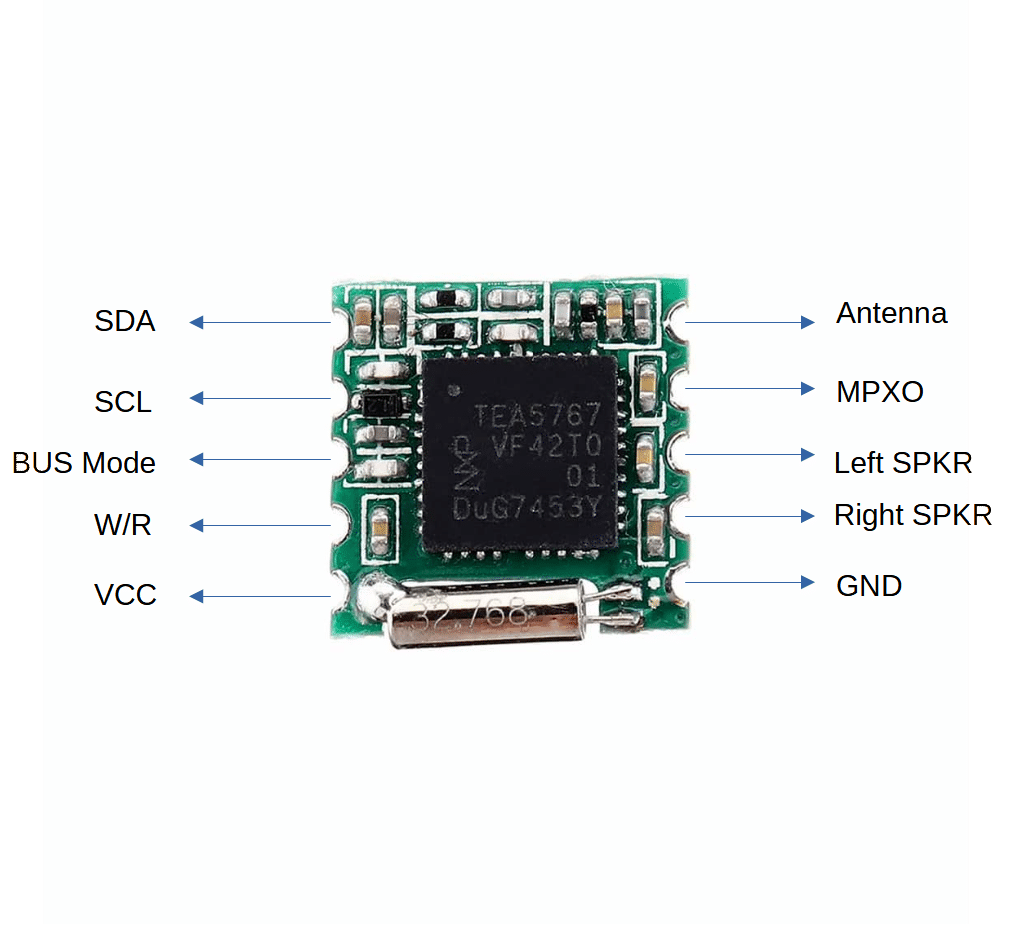TEA5767 FM Radio Receiver Module – User’s Guide
Overview
The TEA5767 is a low-voltage, single-chip FM stereo radio receiver. It communicates via I²C, making it ideal for integration with microcontrollers like Arduino, STM32, ESP32, and others. It supports frequencies from 87.5 MHz to 108 MHz, and includes built-in IF selectivity and demodulation.
Key Features
- Frequency Range: 87.5 MHz – 108 MHz
- Control Interface: I²C (SDA/SCL)
- Audio Output: Stereo via 3.5mm jack or AUX pins
- Power Supply: 3.3V to 5V
- Tuning Resolution: 100 kHz steps
- Built-in: Low-noise amplifier, stereo decoder, and mute control

Pinout Reference
| Pin | Function |
|---|---|
| VCC | Power supply (3.3–5V) |
| GND | Ground |
| SDA | I²C data line |
| SCL | I²C clock line |
| LOUT | Left audio output |
| ROUT | Right audio output |
| ANT | FM antenna input |
Wiring Example (Arduino Mega)
| TEA5767 Pin | Arduino Mega Pin |
|---|---|
| VCC | 5V |
| GND | GND |
| SDA | D20 (SDA) |
| SCL | D21 (SCL) |
| ANT | External wire (~75cm) |
| LOUT/ROUT | Audio jack or amplifier |
Initialization Code (Arduino)
#include <Wire.h>
void setup() {
Wire.begin(); // Initialize I2C
Serial.begin(9600);
setFrequency(101.1); // Set to 101.1 MHz
}
void loop() {
// Add station scanning or mute logic here
}
void setFrequency(float freq) {
uint16_t frequencyB = (freq * 1000000 + 225000) / 8192;
Wire.beginTransmission(0x60);
Wire.write(frequencyB >> 8);
Wire.write(frequencyB & 0xFF);
Wire.write(0xB0); // High side injection
Wire.write(0x10); // Mute off
Wire.write(0x00); // No standby
Wire.endTransmission();
}
Usage Tips
- Use a 75cm insulated wire as an antenna for better reception.
- For stereo output, connect LOUT/ROUT to an amplifier or headphones.
- Avoid long I²C cables to reduce noise.
- You can scan stations by incrementing the frequency in 0.1 MHz steps.
Advanced Integration Ideas
- Pair with an OLED or TFT display for station feedback.
- Use rotary encoders or buttons for manual tuning.
- Integrate with ESP32 for Wi-Fi streaming or remote control.
- Add EEPROM to store last tuned frequency on power-off.
